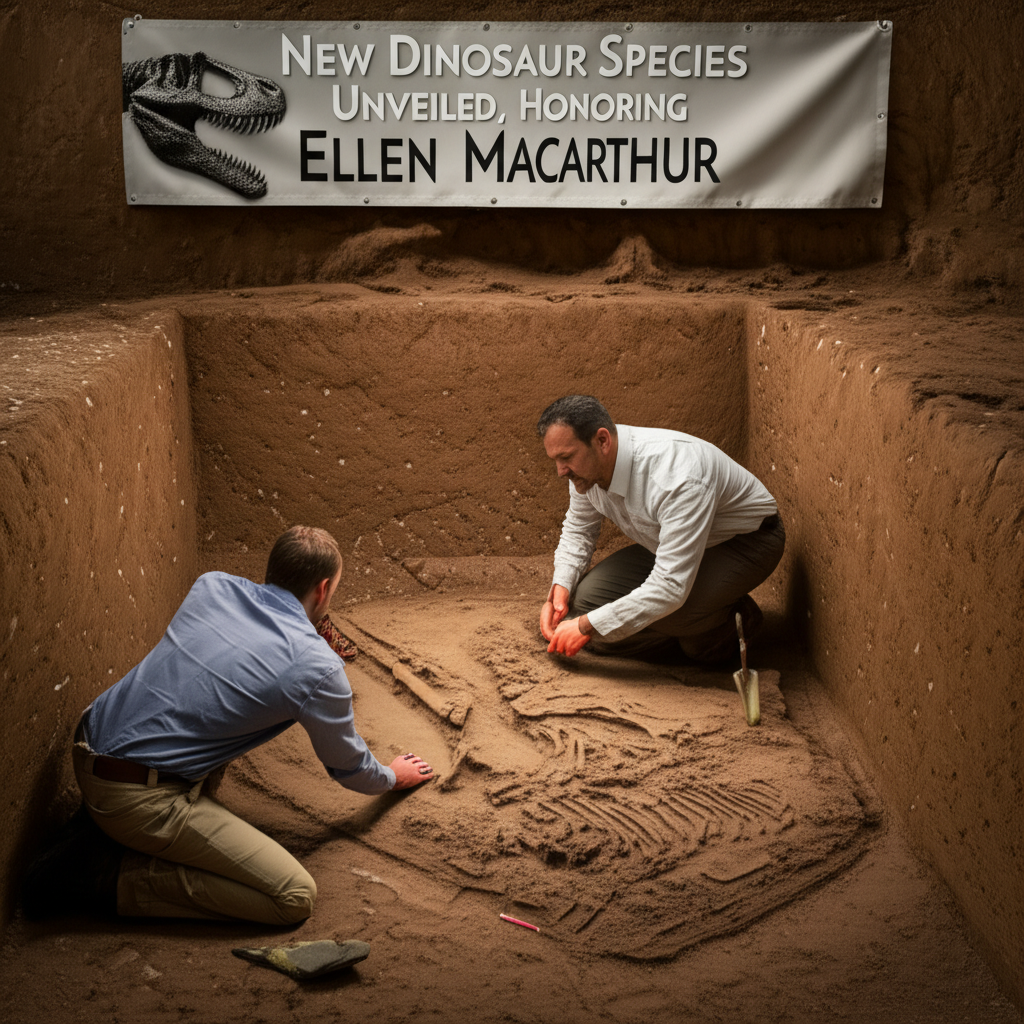New Dinosaur Species Unveiled, Honoring Sailing Legend Ellen MacArthur
Fossil Discovery Sheds Light on Ancient Ecosystems, Connects to Modern Environmental Advocacy
Paleontologists have announced the discovery and naming of a new dinosaur species, a medium-sized herbivore that once inhabited the floodplains of what is now the Isle of Wight’s southwest coast. This significant find, revealed by researchers from the University of Southampton, has been christened *Fodonyx arthuri*, a name chosen to commemorate the esteemed environmentalist and record-breaking solo sailor, Dame Ellen MacArthur. The discovery offers a tangible link to prehistoric life while simultaneously recognizing a prominent figure in contemporary environmental discourse.
Unearthing a Prehistoric Past
The fossil remains of *Fodonyx arthuri*, meaning “Arthur’s Earth Claw,” were unearthed on the Isle of Wight, a region renowned for its rich dinosaur fossil record. The herbivorous dinosaur is described as medium-sized, suggesting it occupied a niche within its ancient ecosystem. The skeletal fragments, meticulously studied by paleontologists, provide crucial insights into the morphology and potential lifestyle of this creature, which roamed the planet millions of years ago during the Cretaceous period.
Dr. Lorna Steel, a paleontologist involved in the research, highlighted the significance of such discoveries: “These fossils are windows into Earth’s distant past. Each one helps us piece together the complex story of life on our planet and the environments that shaped it.” The specific location of the find, on the island’s southwest coast, indicates that this area was once a fertile floodplain, capable of supporting a diverse range of flora and fauna.
A Nod to Environmentalism: The MacArthur Connection
The decision to name the dinosaur after Dame Ellen MacArthur is a deliberate one, linking the ancient past to modern environmental consciousness. Dame Ellen MacArthur is globally recognized for her groundbreaking solo sailing circumnavigations, including setting a world record in 2005. Following her career in sailing, she established the Ellen MacArthur Foundation, a leading organization dedicated to accelerating the transition to a circular economy.
The foundation’s work focuses on redesigning waste and pollution, circulating products and materials, and regenerating nature. This commitment to environmental sustainability and resource management appears to be the primary driver behind the naming of *Fodonyx arthuri*. The act of naming a prehistoric creature after a contemporary advocate for planetary health underscores the ongoing importance of understanding and protecting our environment, both past and present.
While the connection is symbolic, it serves to draw attention to the long history of life on Earth and the impact that environmental conditions have had on its evolution and survival. It also subtly highlights the human responsibility to ensure a sustainable future for the planet’s current inhabitants.
Scientific Significance and Broader Implications
The discovery of *Fodonyx arthuri* contributes to the broader scientific understanding of dinosaur diversity and evolution, particularly within the European fossil record. Each new species identified helps refine our knowledge of prehistoric food webs, migratory patterns, and adaptations to changing environments. The specific characteristics of *Fodonyx arthuri*, based on the recovered fossils, will be subject to further detailed analysis and comparison with other known herbivorous dinosaurs of the period.
The naming convention, while often honoring significant figures or locations, can also serve to inspire public interest in science. By associating a new dinosaur discovery with a well-known personality like Dame Ellen MacArthur, the research team aims to broaden the appeal of paleontology and, by extension, environmental science. This approach can be seen as a strategy to engage a wider audience with the natural world and the scientific endeavors dedicated to its study.
The interdisciplinary nature of this announcement—bridging paleontology and environmental advocacy—prompts reflection on humanity’s relationship with the natural world across vast timescales. The unearthed fossils represent a period when Earth’s ecosystems operated under different pressures, and understanding these past dynamics can offer valuable perspectives on current environmental challenges.
Future Research and Public Engagement
The study of *Fodonyx arthuri* is ongoing, with further research expected to reveal more about its specific characteristics and its place within the Cretaceous ecosystem. Scientists will continue to analyze the fossil material, potentially using advanced imaging techniques and comparative anatomy to draw more detailed conclusions.
The Isle of Wight remains a crucial site for paleontological research, attracting scientists and enthusiasts alike. The discovery of new species like *Fodonyx arthuri* underscores the importance of continued exploration and conservation of fossil-rich areas. Public engagement with such discoveries is vital for fostering scientific literacy and appreciation for natural history.
The naming of the dinosaur after Dame Ellen MacArthur also invites discussion on how scientific discoveries can be leveraged to promote broader societal goals, such as environmental awareness and the adoption of sustainable practices. The intersection of scientific naming conventions with contemporary figures and their influential work highlights a modern trend in scientific communication.
Key Takeaways
- A new dinosaur species, *Fodonyx arthuri*, has been discovered on the Isle of Wight.
- This medium-sized herbivore lived during the Cretaceous period.
- The species is named in honor of Dame Ellen MacArthur, a notable environmentalist and former record-breaking sailor.
- The naming connects prehistoric life with modern environmental advocacy and the circular economy.
- The discovery contributes to the scientific understanding of dinosaur evolution and paleontology.
- Such discoveries aim to enhance public engagement with science and environmental issues.
Further details and the scientific paper describing *Fodonyx arthuri* are expected to be published in peer-reviewed journals, making the detailed findings accessible to the scientific community.


























